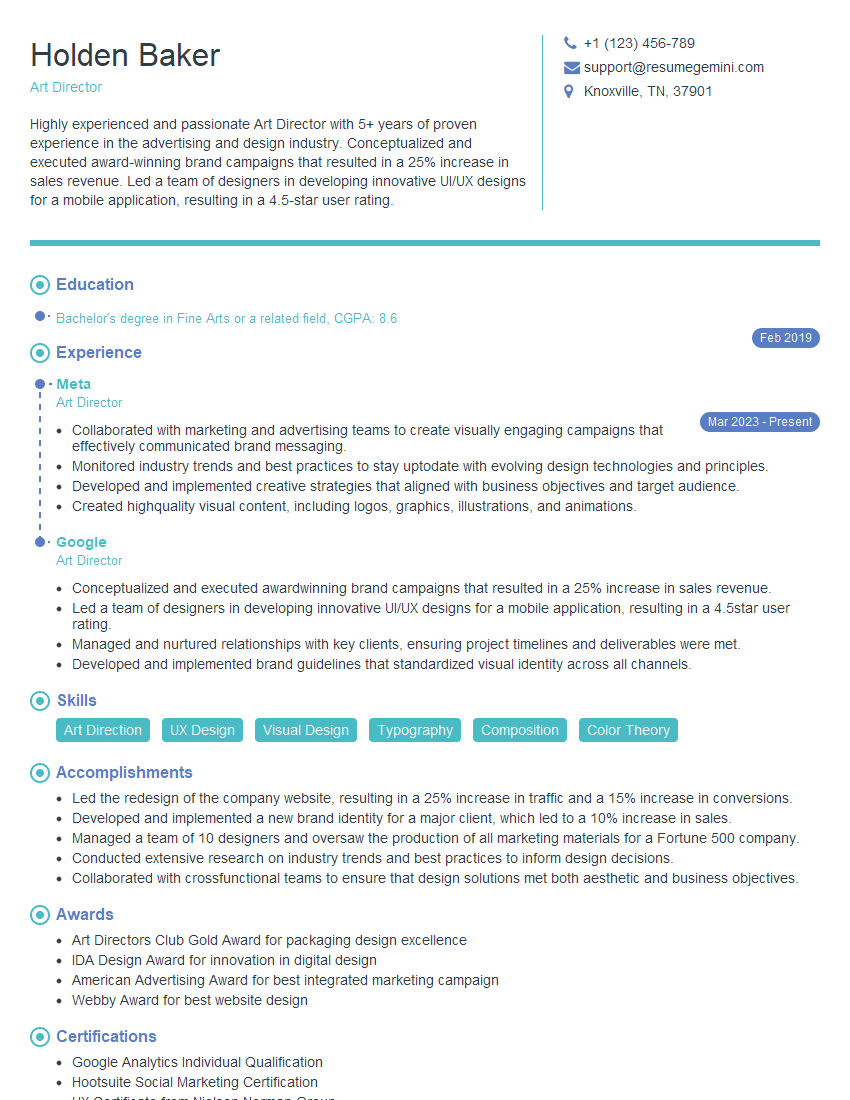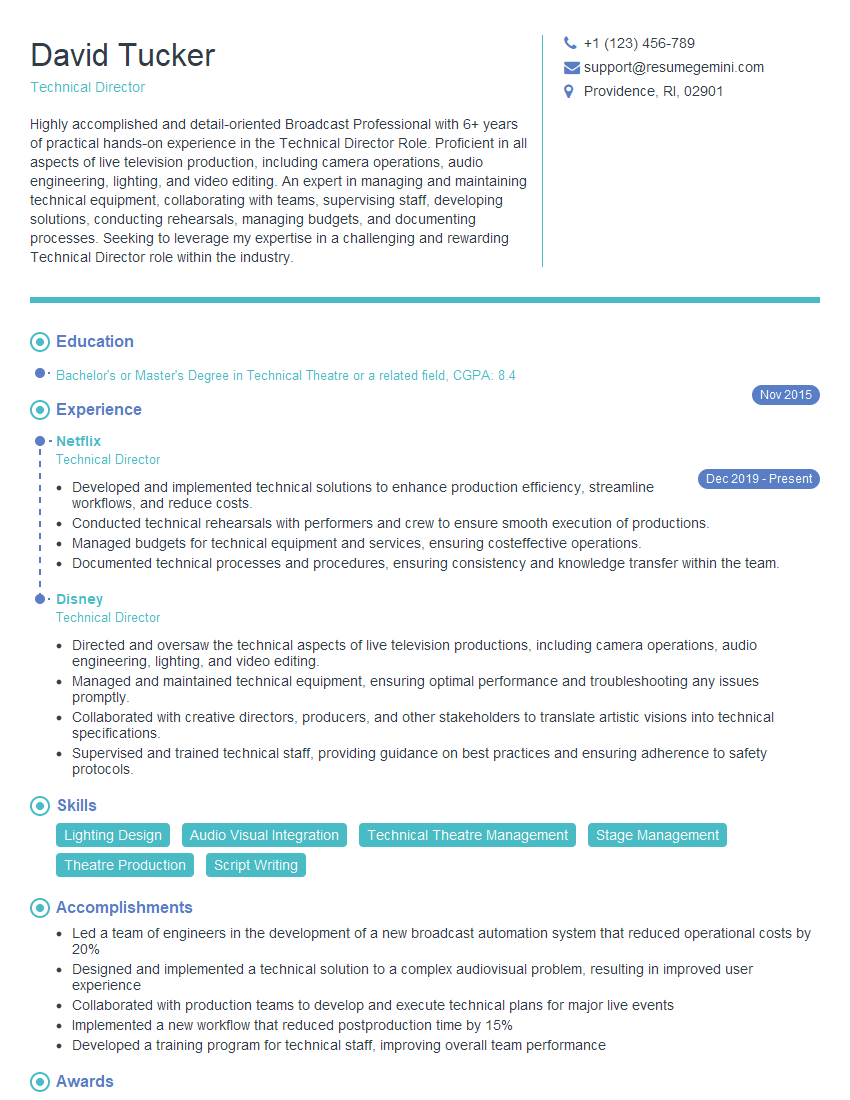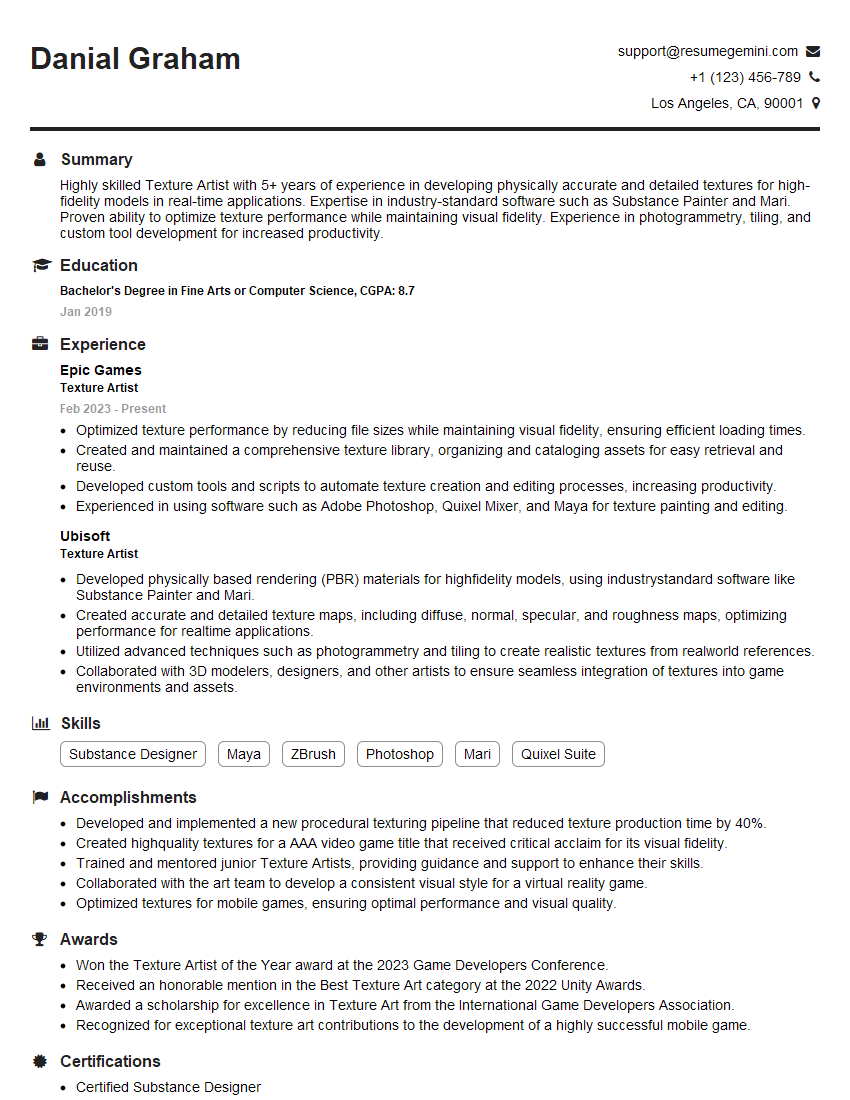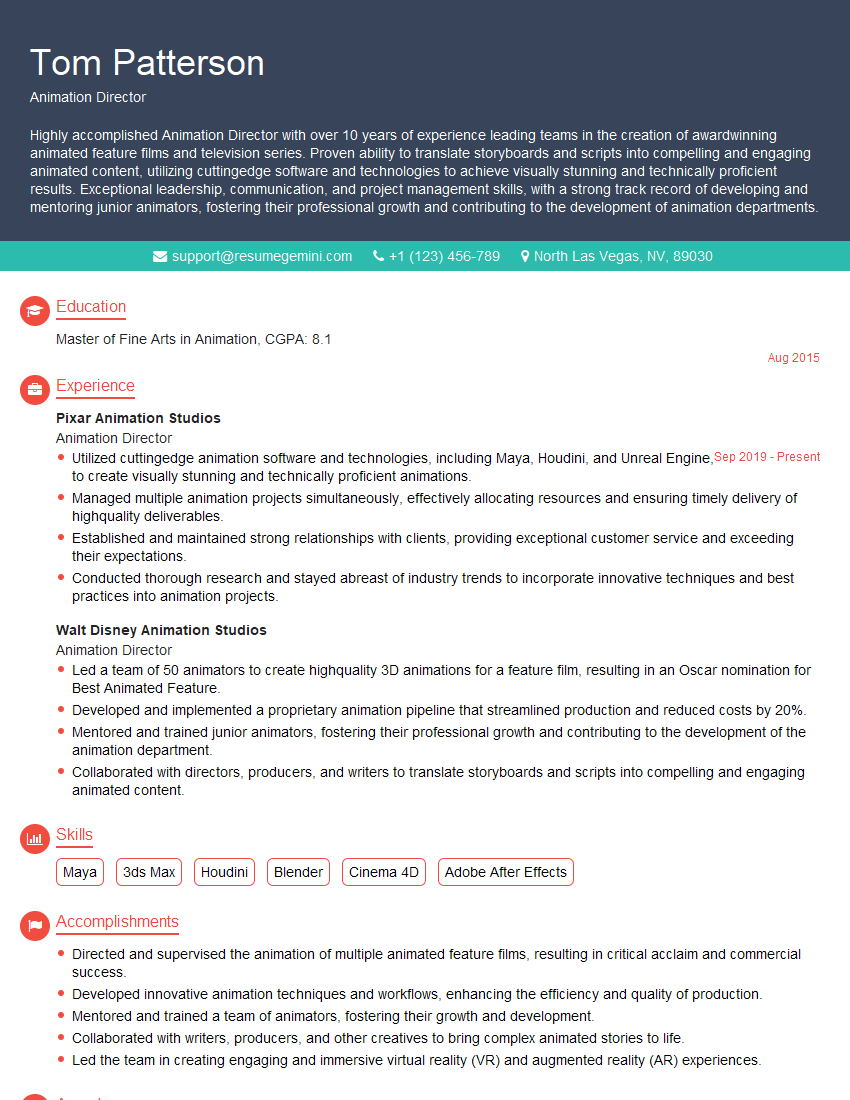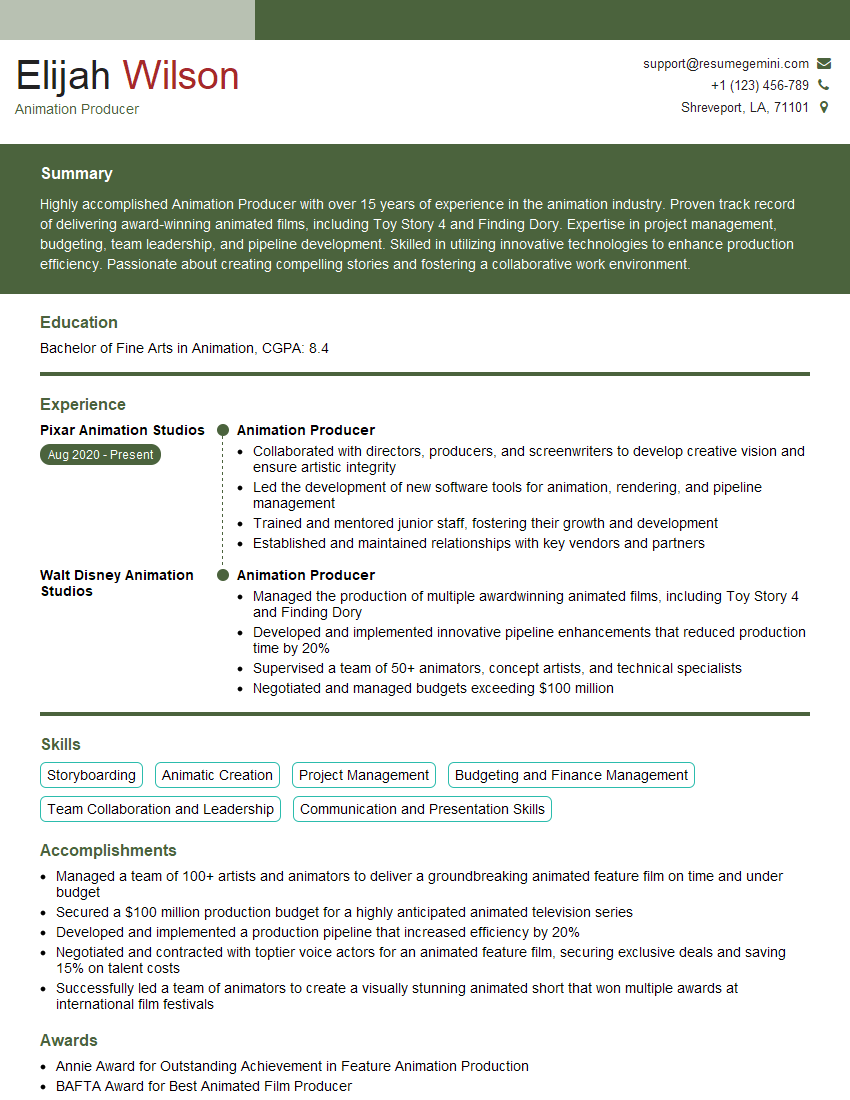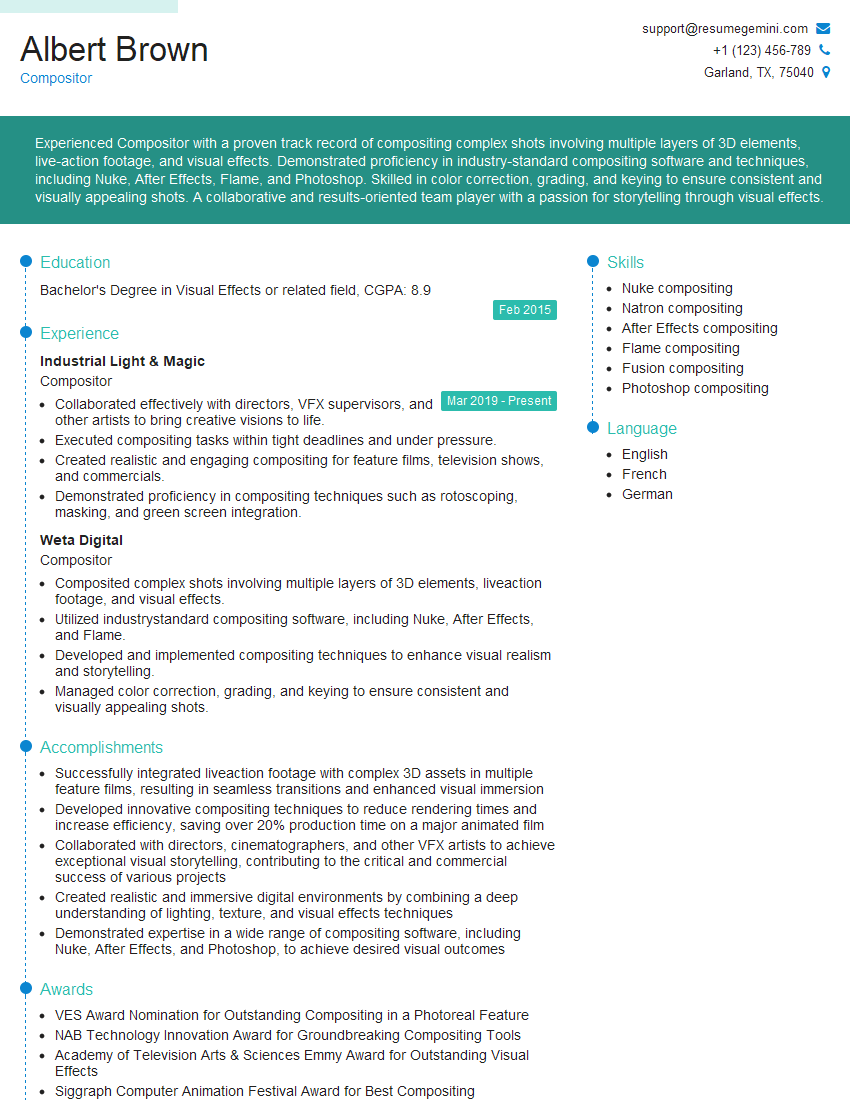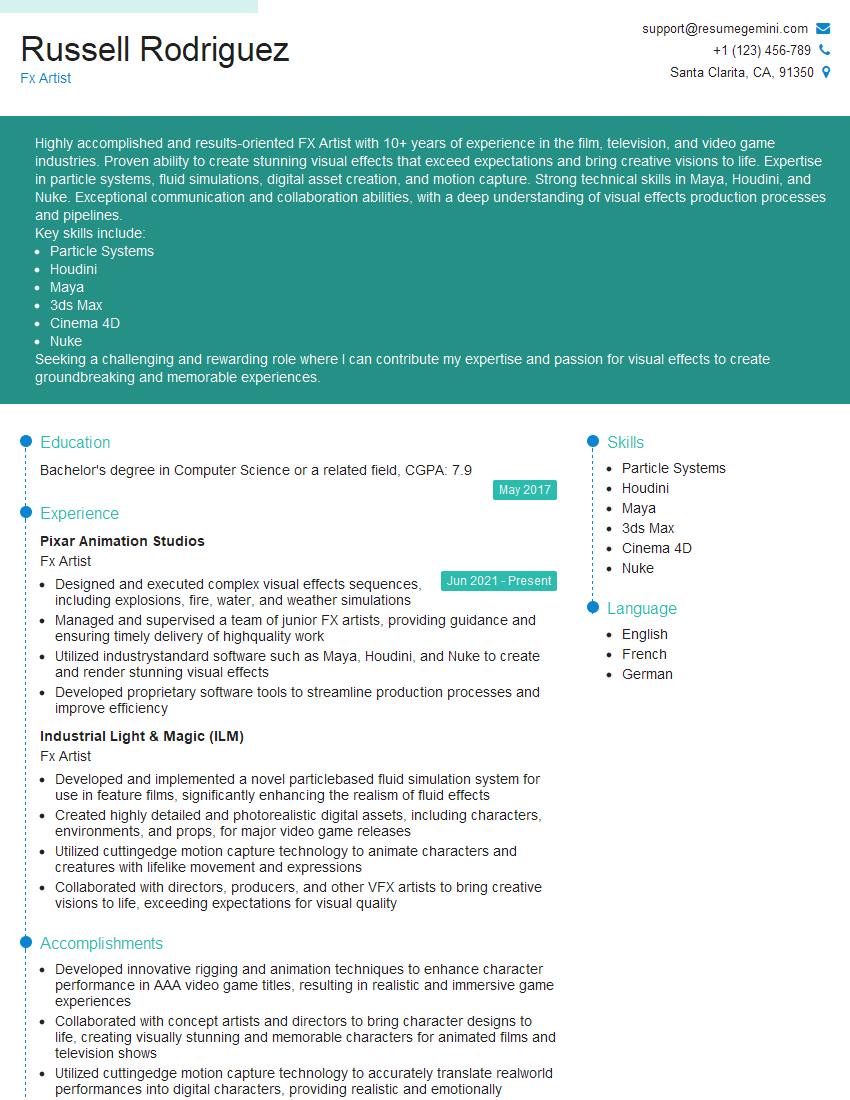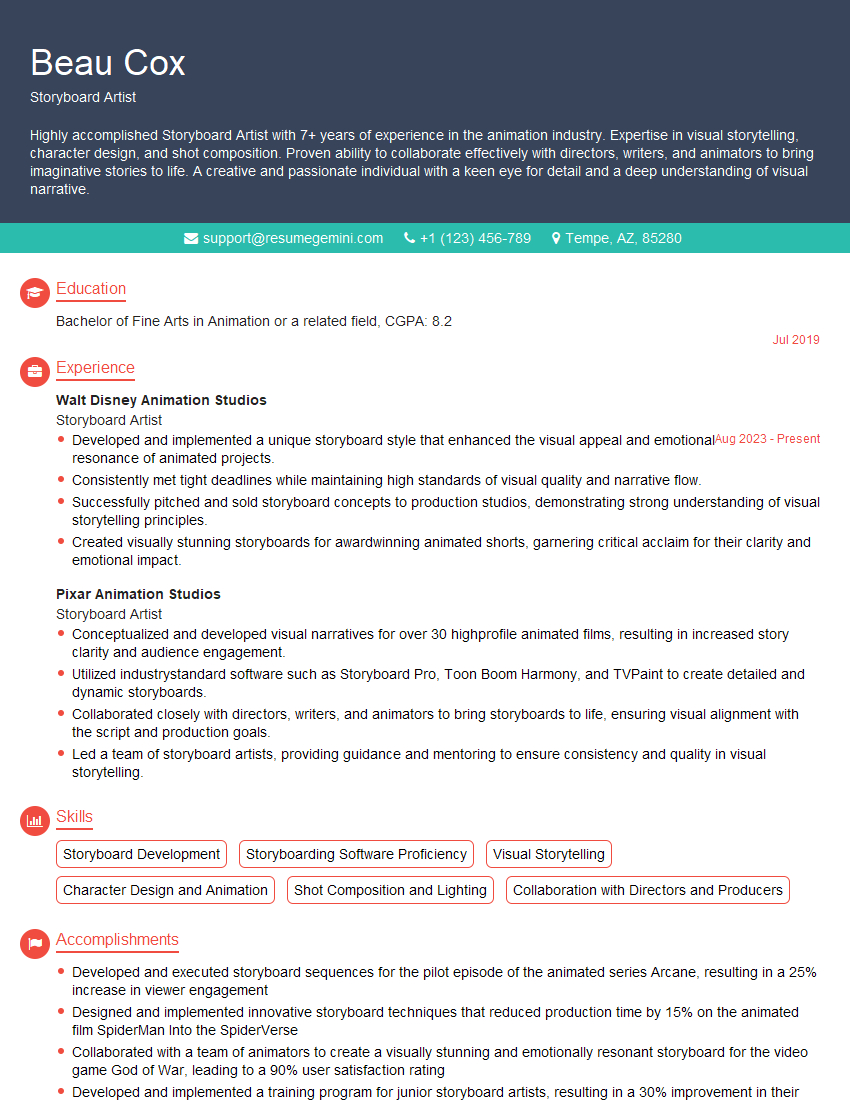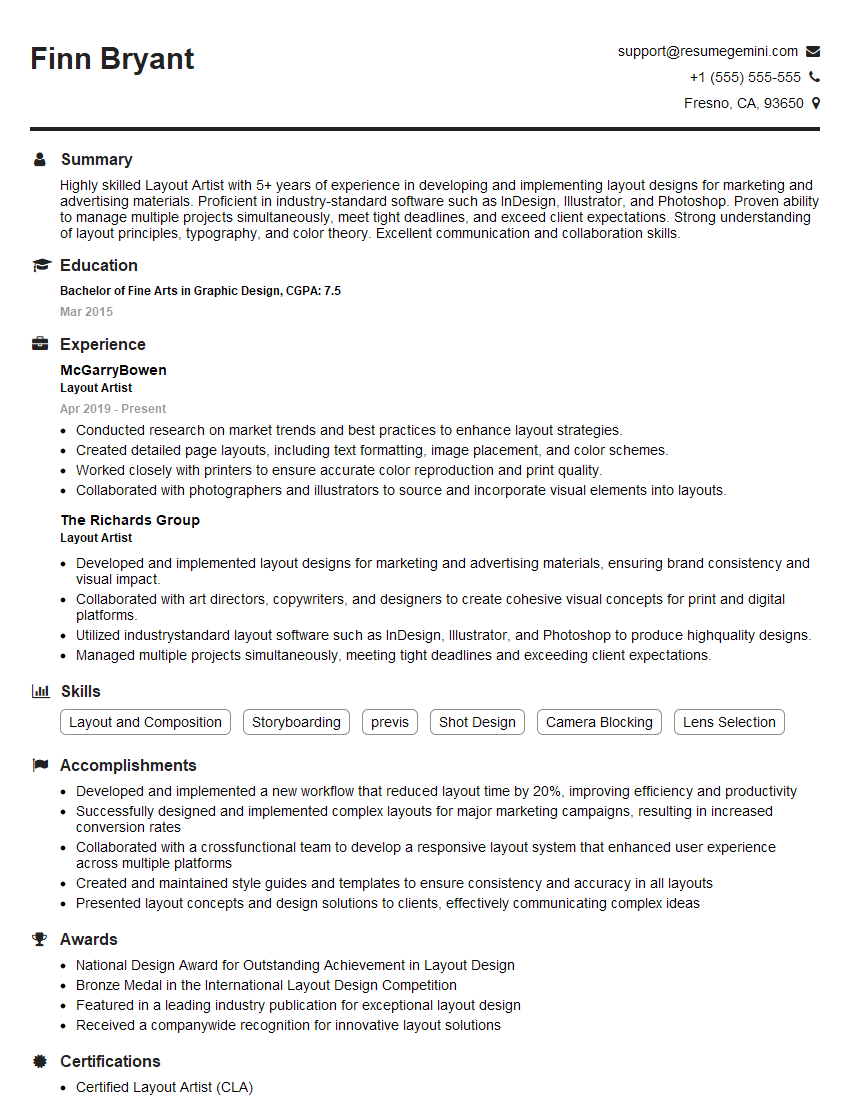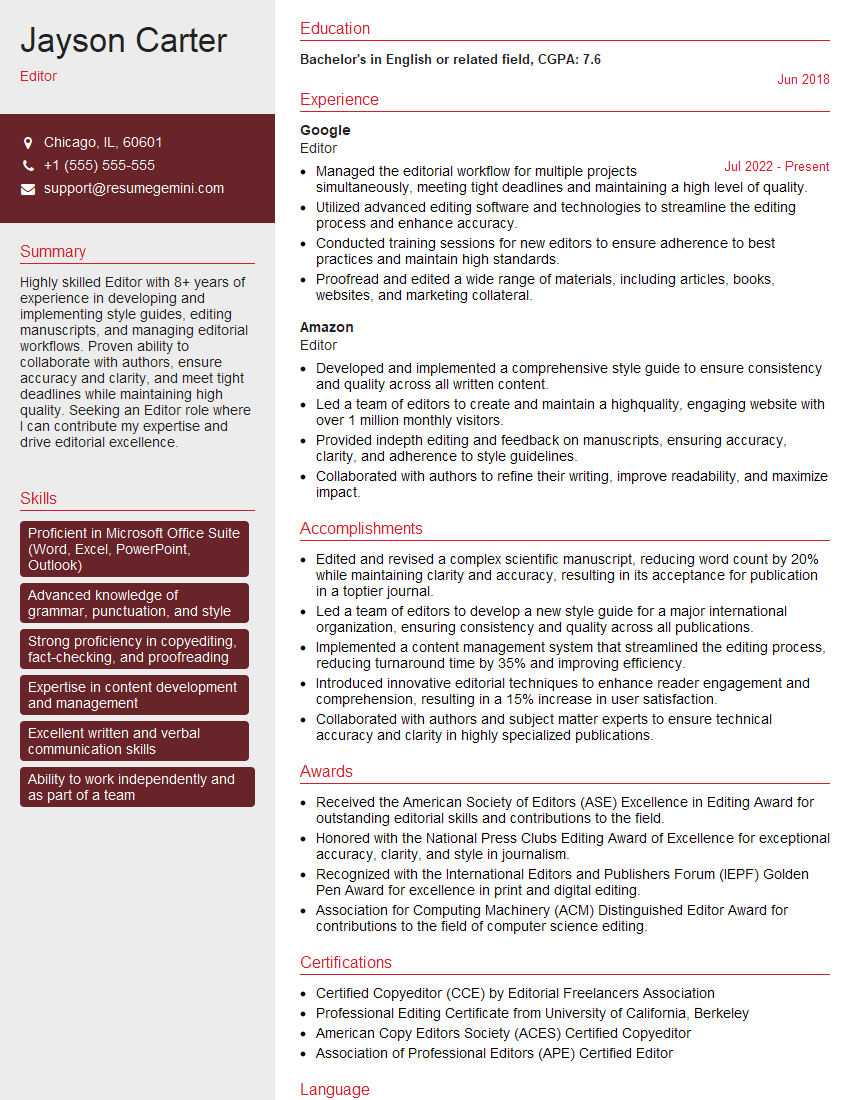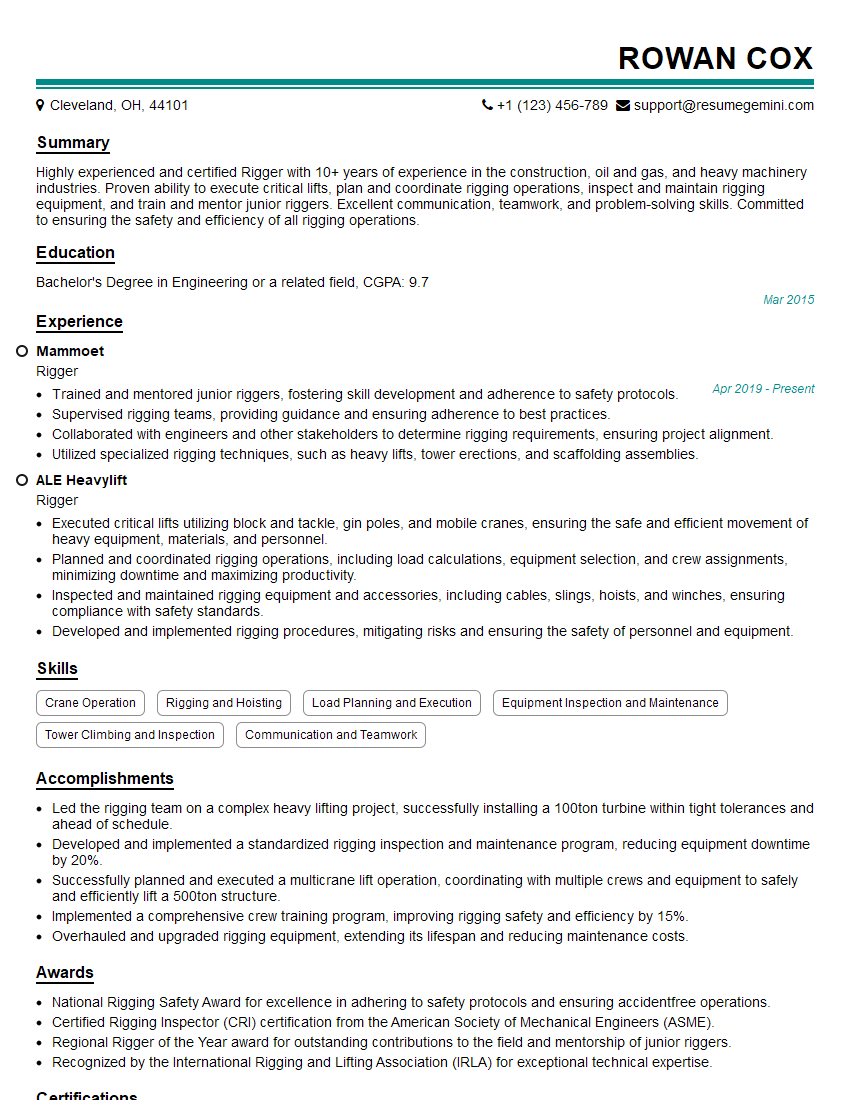Interviews are more than just a Q&A session—they’re a chance to prove your worth. This blog dives into essential Collaboration with Animation Team interview questions and expert tips to help you align your answers with what hiring managers are looking for. Start preparing to shine!
Questions Asked in Collaboration with Animation Team Interview
Q 1. Describe your experience managing communication within a large animation team.
Managing communication in a large animation team requires a multifaceted approach. It’s like orchestrating a symphony – each section (modeling, rigging, animation, lighting, etc.) needs to be in sync. My experience involves establishing clear communication channels and protocols from the outset. This typically includes regular team meetings, utilizing project management software with integrated communication tools (like Slack or Microsoft Teams), and creating a centralized repository for all project assets and documentation.
For instance, in my previous role at [Previous Company Name], we used a combination of daily stand-up meetings for quick updates and weekly progress meetings for in-depth discussions. We also established a clear escalation path for issues, ensuring that problems didn’t get lost in the shuffle. This system significantly improved transparency and allowed us to address potential roadblocks proactively.
Beyond structured meetings, fostering a culture of open communication is crucial. Encouraging team members to openly share concerns, ideas, and progress updates through the chosen channels prevents misunderstandings and allows for collaborative problem-solving.
Q 2. Explain your process for resolving conflicts between different animation departments.
Resolving conflicts between animation departments requires a diplomatic and structured approach. I typically start by understanding the root cause of the conflict, actively listening to all parties involved, and seeking to find common ground. It’s less about assigning blame and more about collaboratively identifying solutions that benefit the overall project.
My process usually involves:
- Identifying the core issue: Often, conflicts stem from miscommunication, unmet expectations, or resource constraints.
- Facilitating a neutral discussion: I create a safe space for all involved parties to express their concerns without interruption.
- Brainstorming solutions: Working collaboratively, we explore various options to overcome the roadblocks.
- Negotiating compromises: Sometimes, this involves adjusting deadlines, re-allocating resources, or finding alternative approaches.
- Documenting the agreement: To ensure clarity and avoid future misunderstandings, we document the agreed-upon solutions and the action items for each department.
For example, a conflict between the modeling and animation teams regarding character rigging could be resolved by scheduling extra time for model revisions or collaborating on a simplified rigging solution that satisfies both team’s needs.
Q 3. How do you ensure consistent quality and style across different animation segments?
Maintaining consistent quality and style across different animation segments is essential for a cohesive final product. This is achieved through a combination of detailed style guides, rigorous review processes, and the use of shared assets.
We start by creating a comprehensive style guide that covers everything from character design and animation principles to color palettes and camera angles. This guide serves as a single source of truth for the entire team. Regular style reviews are conducted to ensure everyone adheres to the guide and to address any inconsistencies that may arise. We utilize a centralized asset library to ensure everyone uses the same approved models, textures, and animation elements.
For example, a project I worked on utilized a style guide with detailed specifications for character movements and expressions, supplemented by annotated reference videos and example shots. This helped maintain stylistic consistency even when different animators were working on various sequences.
Q 4. What software and tools are you proficient in for animation collaboration?
My proficiency extends across a range of animation software and collaboration tools. I’m highly experienced with industry-standard packages such as Autodesk Maya, Blender, and Adobe After Effects. For collaboration, I’m proficient in using cloud-based platforms like Shotgun Software, Perforce for version control, and communication tools such as Slack and Microsoft Teams.
Furthermore, I have experience utilizing other project management tools such as Jira and Asana to track progress, manage tasks, and facilitate efficient team collaboration.
Q 5. Describe your experience using version control systems in an animation project.
Version control systems are crucial in animation projects, preventing data loss and ensuring everyone is working on the latest version of assets. My experience primarily involves Perforce, a popular choice in the animation industry. I understand the importance of branching, merging, and resolving conflicts efficiently. I’m also familiar with Git, although its usage is less prevalent in large animation pipelines.
In practice, I’ve used Perforce to manage hundreds of gigabytes of animation data, ensuring that artists can seamlessly collaborate without overwriting each other’s work. The ability to revert to previous versions is invaluable when troubleshooting technical problems or needing to review past iterations of assets.
Q 6. How do you facilitate feedback sessions and incorporate critique effectively?
Effective feedback sessions are essential for the growth and improvement of the animation. My approach focuses on creating a constructive and respectful environment where team members feel comfortable sharing their thoughts and critiques.
I typically structure feedback sessions as follows:
- Preparation: I ensure that all relevant materials are readily available and that participants have sufficient time to review them.
- Structured presentation: I encourage presenting the work in a clear and concise manner, highlighting key decisions and intentions.
- Constructive feedback: I facilitate a discussion, focusing on specific aspects rather than general statements. I encourage the use of the ‘sandwich method’ –positive feedback, constructive criticism, and ending with more positive feedback.
- Actionable insights: The goal is not just to point out problems but to identify clear and practical solutions. I ensure that feedback is documented and action items assigned.
For instance, in a feedback session, instead of saying ‘this animation is slow,’ I would guide the feedback toward: ‘The pacing in this scene feels a bit sluggish. Perhaps adjusting the timing of these key poses would help create more impact and momentum.’
Q 7. What strategies do you use to manage deadlines and expectations within an animation team?
Managing deadlines and expectations within an animation team requires a proactive and organized approach. This involves creating a realistic production schedule, tracking progress meticulously, and fostering open communication about potential challenges.
My strategy includes:
- Detailed scheduling: Breaking down the project into manageable tasks, assigning responsibilities, and establishing clear deadlines for each phase.
- Regular progress tracking: Utilizing project management software to monitor progress against the schedule, and identify potential roadblocks early on.
- Proactive communication: Keeping the team informed about progress, potential delays, and necessary adjustments to the plan.
- Risk management: Identifying potential risks and developing contingency plans to mitigate their impact.
- Open dialogue: Encouraging open communication about workload, challenges, and resource needs.
I find that regular check-ins and transparent communication prevent unexpected delays and foster team morale. Addressing issues proactively minimizes the impact on the overall timeline and quality of the final project. This approach builds trust and demonstrates a commitment to the team’s success.
Q 8. Explain your approach to mentoring junior animators or artists.
My approach to mentoring junior animators centers around fostering a supportive and challenging learning environment. I believe in a hands-on, collaborative style, moving beyond simply providing feedback to actively guiding their growth. This involves a three-pronged approach:
- Individualized guidance: I start by understanding each animator’s strengths and weaknesses through regular one-on-one meetings and feedback sessions on their work. This allows me to tailor my mentorship to their specific needs, focusing on areas where they need improvement and building upon existing skills. For example, if an animator struggles with character posing, I might assign them targeted exercises focusing on anatomy and weight distribution, along with demonstrating the techniques myself.
- Practical application through projects: I believe in learning by doing. I incorporate mentoring into ongoing projects, assigning tasks that challenge junior animators while providing opportunities to learn and experiment under my supervision. This gives them practical experience and the opportunity to apply new knowledge immediately. I provide constructive feedback at every stage, guiding them towards better solutions rather than simply critiquing mistakes.
- Peer learning and collaboration: I encourage collaboration among team members, allowing junior animators to learn from more experienced colleagues. This creates a positive learning environment where they can ask questions, seek advice, and share their knowledge. I facilitate these interactions by organizing team reviews and group discussions, creating a culture of knowledge sharing.
I also consistently encourage them to explore resources, attend workshops, and participate in online communities to broaden their knowledge and stay updated on industry best practices. My goal is not just to produce skilled animators but to cultivate independent, creative thinkers who can thrive in the industry.
Q 9. How do you contribute to a positive and productive team environment?
Contributing to a positive and productive team environment requires a multi-faceted approach. I prioritize open communication, mutual respect, and collaborative problem-solving. This involves:
- Open and honest communication: I foster a culture where everyone feels comfortable expressing their opinions and concerns. I make sure to actively listen to team members and address their issues promptly and fairly. Regular team meetings are crucial for open dialogue and knowledge sharing.
- Mutual respect and appreciation: I recognize and celebrate individual and team accomplishments. I actively acknowledge the contributions of each member, ensuring everyone feels valued and appreciated for their unique skills and efforts. Positive reinforcement boosts morale and productivity.
- Collaborative problem-solving: I encourage a collaborative approach to problem-solving. When challenges arise, I facilitate brainstorming sessions and group discussions to find the best solutions collectively. This shared ownership fosters team spirit and commitment.
- Conflict resolution: I address conflicts constructively, mediating discussions and ensuring that all viewpoints are heard and considered. My goal is to resolve conflicts efficiently and fairly, maintaining a positive and collaborative atmosphere.
Ultimately, a positive and productive environment is built on trust, respect, and a shared commitment to achieving team goals. By creating a space where everyone feels comfortable, valued, and empowered, I encourage collaboration and innovation, leading to superior results.
Q 10. Describe your experience with Agile or other iterative development methodologies in animation.
My experience with Agile methodologies in animation has been transformative. While traditional animation pipelines often follow a linear approach, Agile’s iterative nature allows for greater flexibility and responsiveness to changes. I’ve worked with Scrum, specifically, where we divide the project into manageable sprints (typically 2-4 weeks). Each sprint involves:
- Sprint planning: We identify and prioritize tasks for the sprint, focusing on delivering a functional increment of animation by the end.
- Daily stand-up meetings: Short daily meetings keep the team aligned, facilitating quick problem-solving and ensuring we stay on track.
- Sprint reviews: At the end of each sprint, we review the completed work, ensuring it meets quality standards and aligning it with the overall project vision. This allows for early identification and resolution of potential issues.
- Retrospectives: We regularly reflect on the processes used during the sprint, identifying what worked well and areas for improvement. This continuous improvement cycle is key to optimizing our workflow.
This iterative approach makes it easier to incorporate feedback, adjust to changing requirements, and manage risks effectively. For example, if client feedback necessitates a change in character design mid-project, we can adapt quickly within the next sprint, minimizing delays and ensuring client satisfaction. This flexibility is invaluable in the dynamic world of animation.
Q 11. How do you handle unexpected technical issues that impact the animation pipeline?
Unexpected technical issues are inevitable in animation. My approach involves a structured problem-solving process:
- Immediate assessment: The first step is to quickly assess the issue’s severity and scope. This often involves collaborating with the technical director or IT to determine the root cause.
- Communication: Transparent communication is crucial. I inform the team and relevant stakeholders about the issue, setting realistic expectations for resolution time. This prevents panic and fosters collaborative problem-solving.
- Problem isolation and diagnosis: We then work systematically to isolate the problem. This may involve testing different aspects of the pipeline to identify the specific point of failure.
- Workarounds and solutions: We explore temporary workarounds to minimize disruption while working on a permanent solution. This might include re-routing tasks or employing alternative software.
- Documentation and prevention: Once the issue is resolved, we document the problem, its solution, and preventative measures to avoid similar issues in the future. This builds our team’s knowledge and reduces the risk of recurrence.
For example, if a rendering node crashes repeatedly, we might investigate hardware issues, update software, or distribute the rendering load across other nodes. In parallel, we would look for temporary rendering solutions to keep the project moving.
Q 12. Explain your experience with remote collaboration tools for animation projects.
My experience with remote collaboration tools for animation projects is extensive. Successful remote work in animation hinges on using the right tools and establishing clear communication protocols. I’ve used various tools including:
- Cloud storage (e.g., Google Drive, Dropbox): Centralized storage is crucial for easy file access and version control, ensuring everyone works from the latest files.
- Project management software (e.g., Jira, Asana): These help to organize tasks, track progress, and manage deadlines effectively, providing a single source of truth for the project.
- Version control systems (e.g., Git): For larger projects, version control helps manage changes to animation files, allowing for easy collaboration and rollback options if needed.
- Communication platforms (e.g., Slack, Microsoft Teams): Real-time communication is essential. These platforms help in quick queries, discussions, and sharing updates.
- Video conferencing (e.g., Zoom, Google Meet): Regular video conferencing fosters collaboration and allows for efficient feedback and review sessions.
- Review and feedback tools (e.g., Shotgun, Ftrack): Dedicated tools streamline the review process, facilitating feedback and approvals efficiently.
Effective use of these tools requires establishing clear guidelines and protocols for file management, communication, and feedback. Regular training sessions and consistent communication are also key to ensure a smooth workflow.
Q 13. Describe a time you had to adapt to a change in workflow or project requirements.
In one project, we initially planned to use a traditional 2D animation workflow. However, halfway through, the client requested a switch to a hybrid 2D/3D approach to incorporate certain special effects. This necessitated a significant change in our workflow and required us to adapt quickly. We addressed this challenge by:
- Team communication: We immediately held a team meeting to explain the change and discuss the implications. This ensured that everyone was on board and understood their roles in the new workflow.
- Skill assessment and training: We assessed the team’s existing skills in 3D animation and identified the necessary training to bridge the skill gap. We organised workshops and tutorials to facilitate the transition smoothly.
- Pipeline adjustment: We adjusted our production pipeline to accommodate the integration of 3D elements. This required changes to our asset management, rendering, and compositing processes. We used Agile methodologies to break down the new tasks into manageable sprints.
- Open collaboration: We fostered open communication throughout the transition, addressing concerns and challenges as they arose. This collaborative spirit was crucial in navigating the uncharted territory.
While the change initially posed a challenge, the team’s adaptability and collaborative spirit allowed us to successfully complete the project, delivering a high-quality product that satisfied the client.
Q 14. How do you ensure that all team members are aware of project updates and changes?
Keeping the team informed about project updates and changes is paramount. My approach involves a multi-channel strategy for effective communication:
- Regular team meetings: Weekly or bi-weekly meetings are held to discuss project progress, address any issues, and disseminate important updates. This provides a forum for questions and discussions.
- Project management software: We utilise project management tools (like Jira or Asana) to track tasks, deadlines, and changes. All team members have access to these systems, allowing them to monitor progress and stay updated on any alterations.
- Communication platforms: Platforms like Slack or Microsoft Teams are used for quick updates, announcements, and addressing urgent matters. This ensures rapid dissemination of information.
- Email updates: For important decisions or announcements, formal email updates are sent to ensure a permanent record and clear communication.
- Visual aids and documentation: Where necessary, we use visual aids like flowcharts or presentations to convey complex information effectively. Regularly updated project documentation also ensures everyone has access to the most current information.
By employing a variety of communication channels, we ensure that all team members, regardless of their roles or locations, remain fully informed about the project’s progress and any necessary changes.
Q 15. What are some common challenges in collaborative animation projects, and how do you overcome them?
Collaboration in animation is a complex dance! Common challenges include miscommunication, conflicting creative visions, scheduling conflicts, and inefficient asset management. Overcoming these requires a multi-pronged approach.
Clear Communication: We establish a robust communication pipeline—daily stand-ups, project management software (like Jira or Asana), and regular feedback sessions. This ensures everyone is on the same page, reducing misunderstandings.
Version Control: Utilizing version control systems like Git for assets and code ensures everyone works with the most up-to-date files, eliminating confusion and preventing accidental overwrites. Think of it like collaborative document editing, but for animation assets.
Defined Roles and Responsibilities: A clear RACI matrix (Responsible, Accountable, Consulted, Informed) defines roles, preventing duplicated efforts and ensuring accountability. Each team member knows exactly what’s expected of them.
Conflict Resolution: We foster an environment where constructive feedback is encouraged. Disagreements are addressed proactively through open discussion and compromise, guided by the project’s overall goals. Sometimes, a neutral party can be beneficial in mediating conflicts.
Agile Methodologies: Adopting an agile approach with iterative development allows us to adapt quickly to changing needs and incorporate feedback throughout the production process. This flexibility is critical for managing unexpected challenges.
Career Expert Tips:
- Ace those interviews! Prepare effectively by reviewing the Top 50 Most Common Interview Questions on ResumeGemini.
- Navigate your job search with confidence! Explore a wide range of Career Tips on ResumeGemini. Learn about common challenges and recommendations to overcome them.
- Craft the perfect resume! Master the Art of Resume Writing with ResumeGemini’s guide. Showcase your unique qualifications and achievements effectively.
- Don’t miss out on holiday savings! Build your dream resume with ResumeGemini’s ATS optimized templates.
Q 16. How do you balance creative vision with technical constraints in animation production?
Balancing creative vision and technical constraints is a constant juggling act. The creative team might envision incredibly detailed characters, but rendering those in a short timeframe might be impossible given the available resources and technology.
My approach involves a collaborative process. Early in pre-production, we involve technical artists and engineers in discussions to assess the feasibility of creative concepts. We might use prototyping to test various design approaches and explore the technical limitations. Sometimes, we need to make compromises. This could involve simplifying certain aspects of the design, optimizing assets, or using innovative technical solutions to achieve a similar visual effect more efficiently.
For example, if the artists want incredibly detailed fur on a character, we might explore different fur rendering techniques or adjust the character’s overall design to reduce the rendering load. This involves open communication and a willingness to explore alternative solutions that maintain the artistic integrity while meeting the technical requirements.
Q 17. Describe your experience with asset management and organization in an animation project.
Effective asset management is the backbone of any successful animation project. Chaos leads to delays and errors. In my experience, we employ a robust system involving a central repository (like Shotgun or a similar system) to manage all project assets—models, textures, animations, sound effects, etc.
Assets are organized using a clear and consistent naming convention. This allows easy searching and retrieval. We use metadata tags to categorize and filter assets, ensuring that everyone can quickly locate the specific files they need. Regular audits are conducted to ensure the database remains clean and organized. This prevents version control issues and keeps the project pipeline efficient.
For example, a character model might be named Character_Hero_Main_v003.fbx, clearly indicating its type, role, and version. The metadata would include details like the artist who created it, the date of creation, and any relevant notes.
Q 18. What methods do you use to track progress and identify potential roadblocks in the pipeline?
Tracking progress and identifying potential roadblocks is crucial. We rely on a combination of methods:
Project Management Software: Tools like Jira or Asana allow us to create tasks, assign them to team members, track progress, and identify bottlenecks. Visual dashboards provide a clear overview of the project’s status.
Regular Check-ins: Daily stand-up meetings ensure that everyone shares their progress and highlights any issues they are facing. This allows for quick identification and resolution of potential roadblocks.
Gantt Charts: These charts provide a visual representation of the project timeline, making it easy to spot potential scheduling conflicts or delays. They are excellent for high-level planning.
Metrics and Reporting: We regularly collect data on tasks completed, time spent on different stages, and the number of bug fixes. This data allows us to identify areas for improvement and optimize our workflows.
By proactively monitoring progress and addressing issues early, we minimize the risk of significant delays and maintain project momentum.
Q 19. How do you evaluate the effectiveness of your team’s collaboration efforts?
Evaluating collaboration effectiveness involves both quantitative and qualitative assessments. Quantitatively, we track metrics like task completion rates, the number of bug reports, and project delivery time. Improvements in these metrics indicate a more efficient collaboration process.
Qualitatively, we conduct team surveys to gauge team morale, communication effectiveness, and the overall collaborative experience. Regular feedback sessions allow team members to voice their concerns and suggestions. We also observe team dynamics during meetings and collaborative work sessions. Are there any communication barriers? Are conflicts being handled constructively? This gives us a holistic view.
Ultimately, a high-performing animation team displays a balance of individual expertise and collaborative synergy, resulting in a high-quality product delivered on time and within budget. The atmosphere is one of mutual respect, open communication, and a shared commitment to the project’s success.
Q 20. Describe your experience with different animation styles and workflows (e.g., 2D, 3D, stop-motion).
My experience spans various animation styles and workflows. I’ve worked on 2D projects using traditional animation techniques (hand-drawn and digital painting), 3D projects using industry-standard software (Maya, Blender), and even a small stop-motion project. Each style presents unique challenges and workflows.
2D Animation: Focus is on drawing, animation principles, and compositing. Workflows often involve storyboarding, animatics, cleanup, and post-production tasks.
3D Animation: Requires expertise in 3D modeling, rigging, animation, texturing, lighting, and rendering. Pipelines are more complex, often involving specialized software and large datasets.
Stop-Motion: Requires physical manipulation of objects, often using clay, puppets, or other materials. Workflows involve meticulous planning, shooting, and editing, and it can be more time-consuming.
My adaptability allows me to seamlessly integrate into different teams, leveraging my knowledge of various tools and techniques to optimize the production process, regardless of the style.
Q 21. Explain your understanding of the animation production pipeline.
The animation production pipeline is a series of sequential steps that transform an idea into a finished animation. It’s like an assembly line, but for creative work.
A typical pipeline includes:
Pre-production: This stage involves concept art, storyboarding, scriptwriting, character design, and asset creation.
Production: This is where the animation happens, including modeling (3D), rigging, animation, lighting, texturing, and rendering.
Post-production: This involves compositing, visual effects (VFX), sound design, music composition, and final editing.
Each stage involves various specialists, and effective collaboration between these specialists is key to success. The pipeline’s specifics can vary depending on the project’s style and complexity, but the core principles remain the same.
Q 22. How do you contribute to the development of style guides and visual references?
Developing style guides and visual references is crucial for maintaining consistency and visual quality across animation projects. My contribution involves a collaborative process, starting with brainstorming sessions with the animation team, art directors, and potentially clients. We define the overall aesthetic, including color palettes, character designs, animation style (e.g., 2D, 3D, cel-shaded), and even specific visual elements like typography and UI design.
Next, I actively participate in creating the actual style guide document. This is often a living document, regularly updated. It includes detailed descriptions, examples, and specifications. For example, if we are animating a cartoon series, the style guide will detail the character’s proportions, expressions, and typical poses. We also create mood boards and visual references – collecting images and artwork that represent the desired aesthetic, helping to clarify visual expectations for the team.
Finally, I ensure the style guide is accessible and easy to understand for everyone on the team. We might use a collaborative platform like Figma or InVision to make the guide readily available, allowing for easy updates and real-time feedback.
Q 23. Describe your process for reviewing and providing feedback on animation work.
My review process is iterative and constructive. It begins with a thorough viewing of the animation sequence, paying close attention to details. I assess aspects like character movement, timing, lip-sync (if applicable), visual appeal, and consistency with the established style guide. I often use annotation tools to pinpoint specific areas needing improvement. For example, if a character’s movement feels unnatural, I’ll note it and suggest more fluid poses or transitions.
I then provide feedback during one-on-one meetings or group critiques. My feedback prioritizes actionable suggestions, avoiding overly critical language. I focus on the ‘why’ behind my suggestions, explaining the impact of the changes on the overall animation quality. The process is collaborative; it’s not just about pointing out errors, but about guiding the animator towards a better solution. I also leverage screen recording software to showcase the problem and demonstrate suggested improvements.
Finally, we track revisions and address any remaining concerns. This entire feedback process is documented for transparency and consistency across the project.
Q 24. How do you use data and analytics to improve team performance and efficiency?
Data and analytics play a vital role in optimizing team performance. We use project management tools to track animation production progress, identifying potential bottlenecks or delays. For instance, tracking the time spent on each animation stage allows us to pinpoint areas where efficiency can be improved. We can then analyze this data to understand why those areas are lagging and implement strategies like improved workflows, additional training, or revised task assignments.
We also use analytics to measure the quality of the animation. This might involve collecting audience feedback on specific sequences or tracking key performance indicators (KPIs) like the number of bugs discovered during QA. Understanding which areas are performing well and which need improvement allows us to make data-driven decisions to enhance our processes.
For example, if we discover a consistent issue with a particular animation technique, we can develop tailored training to improve the team’s skills in that area. This approach ensures that we are proactively addressing challenges and constantly striving for better outcomes.
Q 25. How do you foster innovation and creativity within your animation team?
Fostering innovation and creativity involves creating a supportive and encouraging environment. This starts with establishing a culture of open communication where team members feel comfortable sharing ideas, experimenting with new techniques, and taking calculated risks. We actively encourage brainstorming sessions, both formal and informal, and provide opportunities for team members to explore their creative passions through personal projects or side experiments.
We also incorporate various techniques to spark creativity. This includes regularly showcasing inspiring work from other studios, holding animation workshops focusing on specific techniques or software, and inviting guest speakers to share their insights. We encourage attending industry events and conferences to stay current with the latest trends and learn from others.
Importantly, we embrace constructive criticism and celebrate both successes and failures as learning opportunities. This approach cultivates a growth mindset within the team and motivates everyone to push creative boundaries. We also recognize and reward innovative contributions to inspire further creativity.
Q 26. Describe your experience with client communication and feedback integration.
Client communication is paramount. I establish clear communication channels and regular meetings from the project’s outset. This includes establishing a shared communication platform (e.g., Slack, project management software) and setting up clear expectations regarding feedback turnaround times and communication protocols.
During the project, I proactively provide clients with regular updates, sharing work-in-progress and soliciting their feedback at key milestones. I use visual aids such as annotated animation sequences and presentations to make the feedback sessions effective and efficient. I ensure the client feedback is documented, clarifying any ambiguities and ensuring all team members are aligned.
Integrating client feedback requires a delicate balance. I ensure that the feedback is constructive, and we discuss the technical feasibility and creative implications of any requests. We work collaboratively to find solutions that meet both the client’s vision and the project’s technical constraints. Transparent communication is critical to manage expectations and deliver a successful outcome.
Q 27. What are your preferred methods for documenting processes and workflows within the animation team?
Documenting processes and workflows is critical for consistency and efficiency. We utilize a combination of methods. For high-level processes, we create detailed flowcharts that outline the different stages of animation production, from initial concept to final rendering. These flowcharts are often stored in a central repository (e.g., a shared drive or wiki) for easy access.
For more granular tasks and workflows, we use standardized templates and checklists. For example, a checklist for rigging a character might detail all the necessary steps and ensure nothing is overlooked. We use collaborative documentation tools like Google Docs or Confluence, allowing for real-time updates and team input. This allows everyone to contribute and stay up-to-date with established workflows.
We also leverage video tutorials and screen recordings to demonstrate complex processes. These videos are valuable for onboarding new team members and ensuring everyone understands the best practices for specific tasks. This multi-faceted approach ensures clear and easily accessible documentation.
Q 28. How do you ensure consistent branding and visual identity across your animation projects?
Maintaining consistent branding and visual identity across animation projects requires meticulous planning and execution. This begins with clearly defining the brand guidelines early in the development phase, collaborating with the brand team to understand all facets of the brand’s visual identity. These guidelines might include color palettes, fonts, logo usage, and overall aesthetic preferences.
Next, we develop a comprehensive style guide specifically tailored for the animation project. This guide incorporates the brand guidelines and expands on them with specific details related to character design, animation style, and UI elements. This style guide serves as a central reference point for all team members, ensuring consistent application of the brand throughout the project.
Finally, throughout the project’s lifecycle, we regularly review the animation to ensure consistency with the style guide. We employ quality assurance checks to catch any deviations from established guidelines. This proactive approach ensures a high degree of visual consistency across all animation projects, upholding the brand’s visual identity and promoting a cohesive brand experience.
Key Topics to Learn for Collaboration with Animation Team Interview
- Understanding the Animation Pipeline: Learn the stages of animation production, from concept to final output, and how different roles contribute.
- Effective Communication: Practice clear and concise communication techniques for conveying feedback, providing direction, and resolving conflicts within a team environment. Consider different communication styles and how to adapt your approach.
- Version Control and Asset Management: Familiarize yourself with common software and techniques for managing assets and revisions, ensuring seamless collaboration and preventing loss of work.
- Technical Collaboration: Understand how to troubleshoot technical issues that may arise during collaboration, such as file compatibility problems or software glitches.
- Constructive Feedback & Criticism: Learn how to give and receive feedback effectively, focusing on solutions rather than blame. Practice providing specific, actionable feedback that enhances the team’s work.
- Team Dynamics and Problem Solving: Understand the dynamics of collaborative teams and the importance of teamwork. Develop strategies for resolving disagreements and finding creative solutions to challenges.
- Project Management Fundamentals: Gain familiarity with basic project management principles, such as timelines, milestones, and resource allocation, as they relate to animation projects.
- Software Proficiency (relevant to your role): Depending on your specific role, showcase proficiency in relevant software such as Maya, Blender, Photoshop, After Effects, etc. Be prepared to discuss your workflow and expertise.
Next Steps
Mastering collaboration within an animation team is crucial for career advancement. Strong collaboration skills are highly sought after, leading to increased opportunities for professional growth and higher-level roles. To significantly improve your job prospects, create a compelling, ATS-friendly resume that highlights your collaborative abilities and relevant skills. We highly recommend using ResumeGemini to build a professional and impactful resume. ResumeGemini offers valuable tools and resources to create a resume that truly stands out. Examples of resumes tailored to Collaboration with Animation Team roles are available to help guide your creation.
Explore more articles
Users Rating of Our Blogs
Share Your Experience
We value your feedback! Please rate our content and share your thoughts (optional).
What Readers Say About Our Blog
Interesting Article, I liked the depth of knowledge you’ve shared.
Helpful, thanks for sharing.
Hi, I represent a social media marketing agency and liked your blog
Hi, I represent an SEO company that specialises in getting you AI citations and higher rankings on Google. I’d like to offer you a 100% free SEO audit for your website. Would you be interested?
